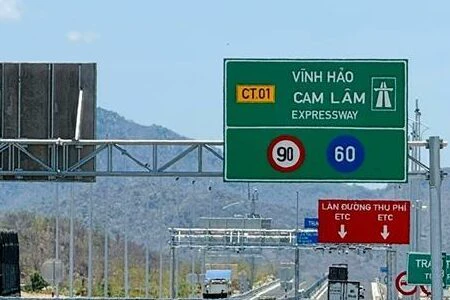The expressway passing through Khanh Hoa - Ninh Thuan - Binh Thuan, officially opened to traffic, making travel from Ho Chi Minh City to the coastal provinces of the South Central region more convenient and faster. The Cam Lam - Vinh Hao section is one of three component projects invested in the form of public-private partnership. The project has a total investment of VND 8,925 billion, with a length of 78.5km, passing through Khanh Hoa, Ninh Thuan and Binh Thuan. The joint venture of investors includes Deo Ca Group, Deo Ca Construction Company and Construction Investment Corporation 194. The Cam Lam - Vinh Hao expressway has completed 70km of road, 35 bridges, two interchanges, 69km of service roads, 2.25km of mountain tunnels, along with equipment systems, ITS systems... and the results of the acceptance have been approved by the State Inspection Council for Construction Works Acceptance. Vietnam Road Administration agreed that Deo Ca Transport Infrastructure Investment Joint Stock Company (HHV) is the unit that manages, operates and maintains the project to ensure that it is put into safe and smooth operation. On the route, there is a 2.2km long Nui Vung tunnel, with a scale of three lanes, a tunnel width of 14m, phase 1 using a right tunnel, two-way traffic. This is the fourth largest road tunnel in the country after Hai Van, Deo Ca and Cu Mong tunnels implemented by Deo Ca Group. To implement the project, the joint venture contractor had to overcome many difficulties in a place with a hot climate all year round, having to pull electricity and water from areas with difficult and complicated terrain... The time of project implementation was also when the Covid-19 epidemic broke out strongly, but with the spirit of working "through the night, through holidays, through the epidemic", Deo Ca Group increased recruitment and training of local human resources, made efforts to mobilize thousands of personnel, machinery, equipment, and arranged project construction teams. Overcoming the "pandemic storm", the project is facing a "material price storm", the project management board has proactively proposed to supplement the material mine according to a special mechanism, combined with the use of agricultural land, using timely tunneling stone sources to serve the construction. Implementing the Prime Minister's direction with the spirit of "overcoming the sun, overcoming the rain", "eating quickly, sleeping urgently", "only working, not talking about retreating" ... the Deo Ca - 194 investor consortium led by Deo Ca Group and construction contractors have gradually overcome difficulties, applying the initiative of the fake reverse arch method to overcome weak geology. At the same time, organize scientific construction, control project progress and costs with new technologies such as biometric facial recognition for personnel management, electronic scales for material control, BIM technology for quality management, and increase construction teams to compensate for progress. After 30 months of construction, the expressway was officially approved on April 26, 2024 to serve the increased demand during the holidays. This is an expressway with an Intelligent Transportation System (ITS), temporary rest stops on the route and an operational management team that has been completed synchronously with the project. In particular, ITS equipment clusters and cameras along the route are arranged to operate on solar energy, saving power consumption, reducing costs and protecting the environment. The ITS system includes surveillance cameras (CCTV) and incident detection, UHF radio information system and loudspeakers (PA, digital transmission (DTS), electronic information boards and signal lights (VMS & SS), Tunnel Control Center... This system is a part of the expressway project, aiming to enhance the connectivity between people, vehicles and expressway infrastructure to optimize operational efficiency, ensure smooth, safe, efficient, convenient and environmentally friendly traffic, especially meaningful in handling incident situations. The camera system on the route is equipped with two types: surveillance cameras (CCTV) and cameras integrated with vehicle detection systems (VDS). These types of cameras use the most advanced specialized AI image processing technology and are also supported by peripheral devices such as infrared and radar. PTZ cameras can rotate 360 degrees, ensuring full-line observation without blind spots; VDS cameras are integrated AI has functions such as vehicle classification, license plate recognition, detection and warning of incidents such as speeding, traffic congestion, stopped vehicles, wrong lane driving, going in the wrong direction, and objects falling on the road. In addition, the project investor proactively spent money to build temporary rest stops along the route to serve people for free while waiting for the Ministry of Transport to approve the investment in building an official rest stop. The temporary rest stop was built in just 20 days, arranged clean restrooms, pulled grid power, installed air conditioners, and drilled a nearly 300m deep water well to overcome difficulties in water sources for operating the rest stop.


